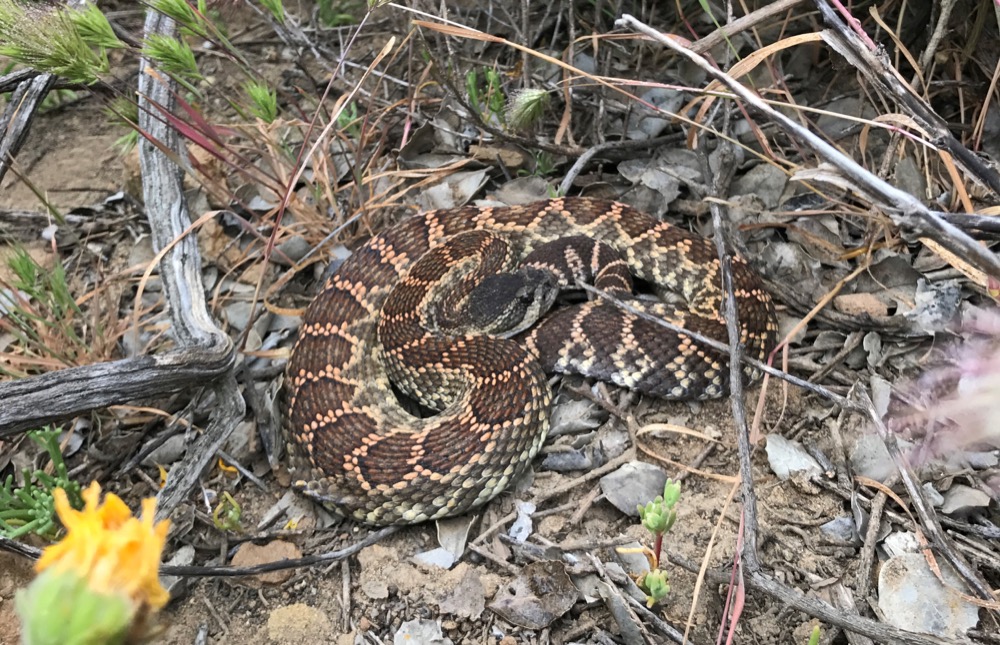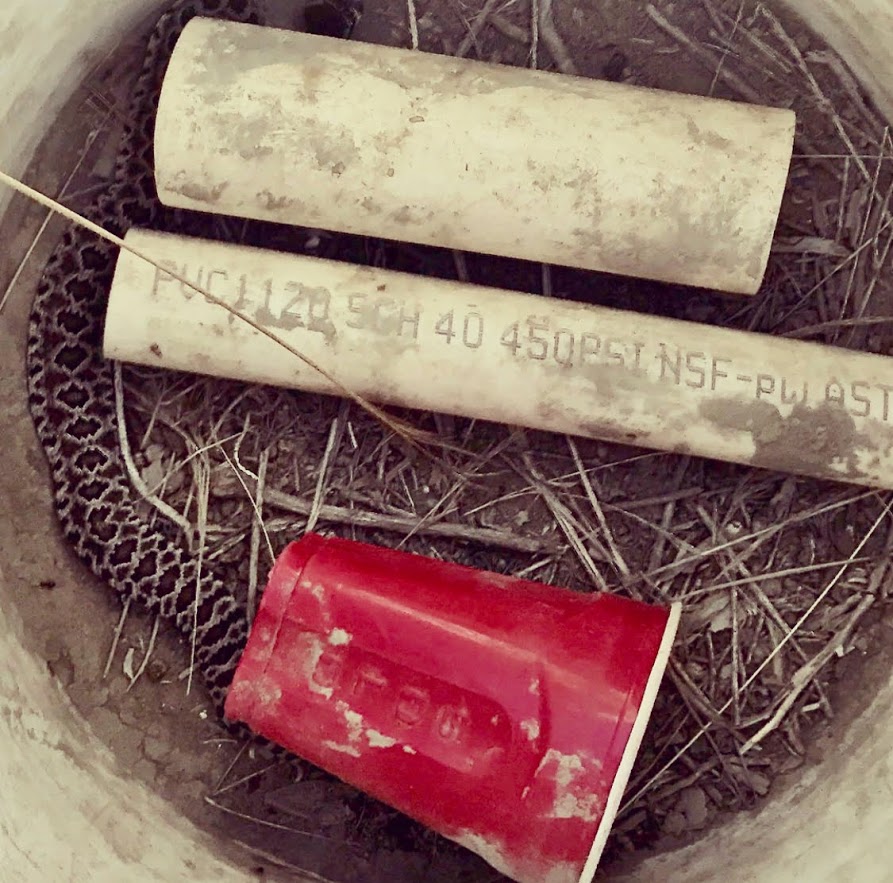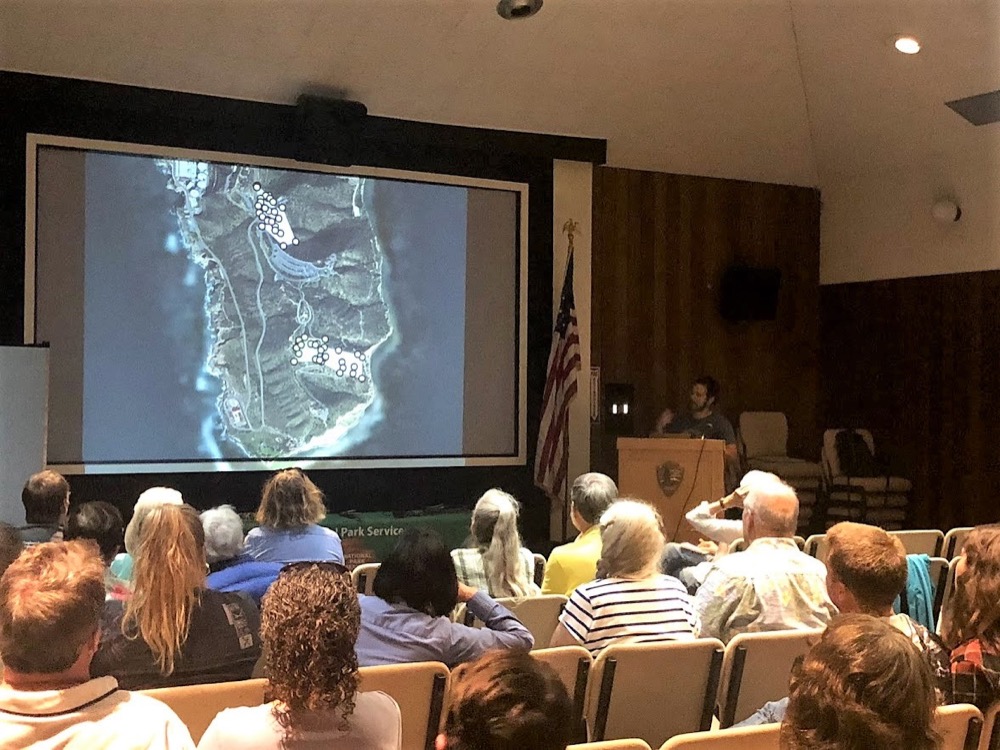San Diego County is home to four species of rattlesnake – the Red Diamond, Sidewinder, Speckled, and Southern Pacific (Crotalus oreganus helleri), Cabrillo National Monument’s only species and the focus of this article. With a stout body and triangle-shaped head, the defining characteristic of all rattlesnakes is their segmented rattle. Rattlesnakes belong to a larger family of “pit vipers,” including cottonmouths and copperheads, that have heat-sensing pits near their eyes to help them detect prey. Like other rattlesnakes, the Southern Pacific Rattlesnake is an ambush predator that relies on its cryptic coloration to stay hidden. When the right prey comes along, the snake delivers a quick bite to inject the prey with venom, eventually paralyzing the prey and making it easy to consume. Southern Pacific Rattlesnakes occupy a variety of habitats throughout Southern California and feed primarily on small mammals.
 NPS Photo – a Southern Pacific Rattlesnake (Crotalus oreganus helleri).
NPS Photo – a Southern Pacific Rattlesnake (Crotalus oreganus helleri).Okay, I’ll admit that all that sounds pretty scary. And I’m not saying that rattlesnakes aren’t dangerous; they are. But these snakes don’t want to bite humans, so any bite that does occur is probably out of self-defense. If you mind your business and give them space, they will do the same for you. Plus, rattlesnakes play a vital role in the ecosystem. They are a top predator here at Cabrillo, helping to keep rodent populations in check and therefore supporting a healthy plant community.
As an island-like peninsula, Cabrillo National Monument serves as an interesting place to study these animals. Due to the rapid urbanization of San Diego in recent decades, the rattlesnake population here has been cut off from the mainland. Roman wants to know how these animals are faring in the wake of this rapid habitat fragmentation, and how they might adapt over time.
 NPS Photo – a small Southern Pacific Rattlesnake found in a pitfall trap during herpetofauna monitoring at Cabrillo National Monument.
NPS Photo – a small Southern Pacific Rattlesnake found in a pitfall trap during herpetofauna monitoring at Cabrillo National Monument.To study these amazing creatures, Roman recently captured, tagged, and released four rattlesnakes at the park, and is using radio telemetry to track their movements (for more on that, check out this Field Note from last year). He is also conducting behavioral studies on snakes at different sites, including Camp Pendleton, Mission Trails, and the Coronado Islands in Mexico. Knowing where and when the snakes move can help him answer questions such as how the behavior of the snakes might be influenced by smaller or larger foraging areas. Mainland snakes (from Mission Trails and Camp Pendleton) are large and aggressive, while island snakes (from Coronado) are small and docile. Are the island-like snakes of Cabrillo adapting to become more like the Coronado snakes? Or are they becoming more aggressive like the mainland snakes as they are forced closer together? Answering these questions will help us better understand how to protect the species for the future.
As we anxiously await the results of Roman’s study, remember to care for our scaled friends as we do everything else in the park – always stay on designated paths and trails, and keep the park trash-free. If you happen to see a rattlesnake while exploring the park, make sure to let a Ranger or volunteer know so it can be properly taken care of.
 NPS Photo/Nicole Ornelas – Speaker Roman Nava speaks to lecture attendees on July 19.
NPS Photo/Nicole Ornelas – Speaker Roman Nava speaks to lecture attendees on July 19.*A special thank-you to Roman Nava for his fantastic lecture on July 19. If you would like to become a Foundation member and attend future members-only events, visit the CNMF website at: https://cnmf.org/shop/membership/
**Our final Naturally Speaking lecture, entitled Tolerating the Flames – Wildfire Ecology, will feature former Chief of Natural Resources and current Director of the Research Learning Center for the Mediterranean Coast Network, Keith Lombardo. His talk will explore the role that wildfires play in Southern California chaparral ecology. The event will be held Thursday, September 20 from 6-8 pm in the Cabrillo National Monument Auditorium. RSVP to this CNMF event here: https://docs.google.com/forms/d/e/1FAIpQLSfIThLgmG1lMDHS4V2K4tKVrUW0qH0wR48HPmv3BPu4TYOf6g/viewform
